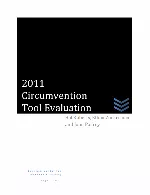
2011 Circumvention Tool Evaluation
Given the rising awareness of the potential of the Internet as a political space and increasing government control over the space, it is easy to understand the widespread interest in finding technical solutions to Internet filtering. While filtering circumvention technologies emerged in 1996 with Bennet Hazelton’s Peacefire, designed to evade filtering within US high schools and universities, in recent years, there’s been a great deal of interest in the technical community and the general public in the topic of Internet circumvention. The embrace of an “Internet freedom” agenda by US Secretary of State Hillary Clinton in a pair of widely publicized speeches has increased awareness of the challenges of Internet filtering and encouraged new actors to explore or enter the field.
The prospect of expanded fiscal support for tool development and deployment has led to debate in the popular press about the strengths and weaknesses of various circumvention tools and strategies. These debates make clear the need for scholarly research on the efficacy of various tools.
This study uses a novel methodology for conducting in-country testing without requiring a researcher to be physically present in censored nations. While this method does not fully replicate the performance of circumvention tools from a cybercafé in a filtered nation, it can be regularly replicated, allowing us to conduct tests over a long period of time and, potentially, create an ongoing, regularly updated portrait of circumvention tool usability in locations across the globe. In this report, we focus on questions of utility—the ability for a tool to be installed and used in a particular location, and the accuracy and speed of the tool. Additionally, we address concerns about security, usability and openness when appropriate.
This evaluation also differs from our earlier work (2007 Circumvention Landscape Report; 2010 Circumvention Tool Usage) in that we cover significantly more tools and examine two classes of tools (ad-supported proxy servers and VPN services) which we did not review previously. We expanded the set of tools considered to recognize the increased number of options that users in censored nations may choose from, and to acknowledge results of our previous research which suggest that simple web proxies and VPNs have a very significant user base in comparison with dedicated censorship circumvention tools.
This work is supported in part by the U.S. Department of State and Internews.
You might also like
- communityTrapped by what they know


